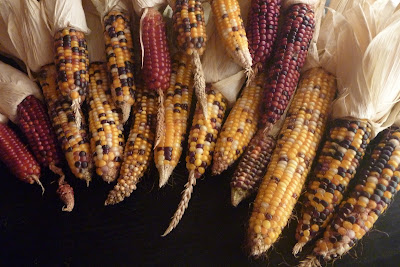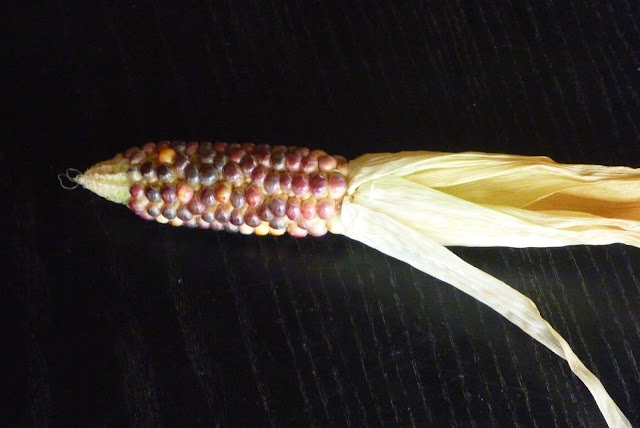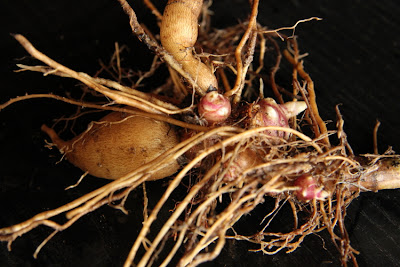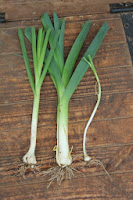Organic Heirloom Vegetable Seeds - most are not perennial
but it is certainly worth growing these.
Postage of seeds only within Australia: $3.50 for any number of packets. If also buying plants use the plant postage rate as I will send everything in the one package. I can also post some seeds overseas but I post at cost so need to confirm postage costs with the post office.
Immali Corn (Zea mays) a beautiful and delicious coloured sweet corn. I have created this amazing variety myself, the colours are not changed during cooking (we ate the cob in the photo). Produces 2 to 6 cobs of coloured sweet corn per plant. This is high in anthocyanin, antioxidants and vitamins. Why grow yellow corn when this is prettier,
tastier, and healthier for you! Corn will cross pollinate with other varieties of corn so you may have some yellow seeds if
someone is growing yellow corn near by $
4.00 per packet of about 20 seeds
Giant Heirloom Tomatoes (Lycopersicon esculentum) a mix of seeds containing both "Julia Child" and "Giant Siberian Pink" (known in Russian as: Sibirskiy
Velikan Rozovyi). They are both delicious and large tomatoes. 'Julia
Child' grows regular leaf and 'Giant Siberian Pink' grows potato leaf so
you can tell from a young age which seedlings are which. These are
open pollinated varieties that are both indeterminate. $4.00 per packet
of about 20 seeds
Angora 82 tomato small plant which grows to about 1 foot tall, may or may not be dwarf, very productive
with about 20 flowers per truss. Small, red, round tomatoes which taste
really nice and sweet. This plant gave a large yield very early, has regular
leaf and appeared to be determinate but kept putting out occasional new
branches with flowers until the frosts. $4 per packet of about 20 seeds
Igloo tomato, stocky plants, around 1 foot tall. Highly productive, producing about 12 kg of remarkably consistent red round fruit that weighs just under 50g each. Each truss usually contains about 16 flowers. Very early cropping, great for producing a lot of food under short seasons and small spaces. $4 per packet of about 20 seeds
Little Oak Like
tomato small determinate tomato that produces red ping pong ball size
tomatoes. Like many other old Russian varieties it has a very rich
tomato taste. Looks much like 'Igloo' but slightly less stocky, a bit
tastier, and less productive. Very early cropper great for areas with a
short growing season. $4 for a packet of about 20 seeds
Micro Tom tomato
the smallest variety of tomato in the world! I have never had one grow
over 10cm tall. Being so small they can easily be grown in a cup of
soil, easy for kids to grow, easy for elderly people who no longer have a
garden, easy to grow in apartments if you have a sunny window, and
great for school experiments due to its short life cycle $4 for 15
seeds
Yellow Pear Tomato (Lycopersicon
lycopersicum) a sweet, yellow, pear shaped cherry tomato. This is an old and loved heirloom variety
dating back to the 1700’s. It was the
first yellow tomato I ever grew. It can grow to be a large plant if given
support and is very productive if treated well.
Beautiful, delicious, sweet and easy to grow, kids love the look and
taste of the fruit. Heirloom tomato can
and will cross with other varieties of heirloom tomato so be a little careful if saving
seed $4.00 per packet of about 20 seeds

Skirret (Sium sisarum)
very rare, endangered and ancient perennial root crop which is simple
to grow. Sweet roots taste like a delicious sweet potato or
parsnip. Used in any dish that calls for potato, carrot or parsnip.
Leaves can be added to salads but it is the sweet roots that are the
main crop here. Flowers attract many beneficial insects to
your garden. Unlike many other perennial vegetables, seed grown plants
will produce a crop, divide numerously, flower, and set seed the first
year $4 per packet of tiny seeds
 |
|
Superior Coriander (Coriandrum sativum)
mixed seeds of around a dozen varieties including 'slow bolt', 'long
standing', and 'Bengal Giant'. This is an excellent producer of both
leaves and seeds. There has been deliberate crossing of varieties so
you will have great genetic diversity and be able to breed a superior
variety that performs well in your garden. Cull plants that
flower early and only save seed from later flowering plants to quickly
and easily develop your own variety that is is slow to flower and
produces abundant leaves $4 per packet of seeds
 Cape Gooseberries
Cape Gooseberries (
Physalis peruviana)
is also known as Incaberry, goldenberry, pichuberry, and a few other
common names. Highly productive plants producing over one kilogram of
small ~2g fruits that are covered with a protective paper husk. The
fruits fall from the plant when ripe. For me they take a little over 80
days from planting the seed until eating perfectly ripe berries $4
per packet of tiny seeds
 Hillbilly
Hillbilly tomato
has firm flesh that is reasonably dry and somehow smells very fruity.
Produces a medium yield of glossy fruit over
the season, it has regular leaf and is indeterminate. Good size for
slicing on a sandwich, the colour, glossiness, and fruity smell are all
enjoyed by my kids. $4 per packet of 20 seeds
 Cherokee Purple
Cherokee Purple grows large tomatoes, some round, some a little odd shaped.
People often
say this tomato has a smoky taste or taste of good red wine. A little salt adds
more depth and complexity to their taste - Unbelievable! This plant produces a medium
to large yield of large fruit, it has regular leaf and is indeterminate. $4 per packet of 20 seeds
 Japanese Black Trifle
Japanese Black Trifle
(spelled various ways, originally called "Yaponskiy Trufel Chernyi" or
in Russian "Японский трюфель черный"). This old Russian variety has a
deep, rich, sweet, tomato taste that is
difficult to describe but easy to remember. One of my all time
favourite tomatoes. Japanese Black Trifele tomato has potato leaf
and is indeterminate. $4 per packet of 20 seeds
 Helsing Junction Blues
Helsing Junction Blues
are great high anthocyanin cherry tomatoes. These taste sweet and
are very productive. The unripe fruit is bright
purple, only goes blue/black where the sun hits and stays red when
shaded by a leaf so you can make patterns using stencils
similar to apples. Ripe fruit is
red with black where it used to be purple. Plants have regular leaf
and are indeterminate. $4 per packet of 20 seeds
Tommy Toe
tomatoes (I didn't take a photo) grow into a large plant with high
yields of small tomatoes. An excellent tomato for back yard growing due
to their rich tomato taste, abundant yield, and pretty red round cherry
tomatoes. One of the more common varieties I grow as they are well
worth growing. Plants have regular leaf and are indeterminate. $4 per
packet of 20 seeds

Sarah's Galapagos tomatoes
grow a large plant, high yields of small red cherry tomatoes. They have
a surprisingly deep rich taste for such tiny fruit. It is said to be
originally found on Galapagos Islands where they were eaten and
dispersed by giant tortoises. Plants have regular leaf and are
indeterminate. $4 per packet of 20 seeds
Giant Parsley (
Petroselinum crispum)
is an absolutely massive strain of flat leaf parsley that is very
simple to grow. Leaves can be used as vegetable or herb, petioles can
be used in place of celery, roots are delicious roasted. Contains wide
genetics and will produce a diverse population containing some
large plants and some stunningly massive plants. If allowed to flower it will attract many
beneficial insects and pollinators, and will gladly self seed. $4 per
packet of seeds
Giant Edible Dandelion (
Taraxacum officinale)
produces incredibly large plants from improved parent stock. Dandelion
leaves are more nutritious than most vegetables, the thick long roots
can be roasted or turned into delicious coffee substitute, even the
pretty flowers are edible. Poultry and livestock love to eat
dandelions. Deep tap roots mine minerals from deep in the soil, leaves
can be used as compost activators. They are great companion plants for
most fruits and vegetables. The flowers are pretty and are great for
bees, and kids love to blow the seed heads. Open pollinated plants may
display some genetic diversity $4 per packet of seeds
 Wasabi salad herb
Wasabi salad herb (
Diplotaxis erucoides)
is a leaf vegetable/herb that is far simpler to grow than
true wasabi, tastes similar to wasabi, gives a similar nose tingling
feeling as wasabi, and lacks the extreme heat of true wasabi. Great in
salads and on sandwiches. It happily self seeds in my garden, sometimes
pops up in my lawn, and is low/no maintenance. It is can form a self
sustaining patch that flowers all year and is excellent bee forage. $4
per packet of tiny seeds
 Purple Mustard - back in 2012 I bought some seeds for purple mustard.
My son loved purple mustard, and has saved
seed and grown it every year since. Leaves can be used as vegetable, or garnish, and seeds can be used to make condiment. They produce large purple
leaves with some green, profuse yellow flowers attract honey bees and other beneficial insects. All
profits from this go to my son for pocket money $4 per packet
Purple Mustard - back in 2012 I bought some seeds for purple mustard.
My son loved purple mustard, and has saved
seed and grown it every year since. Leaves can be used as vegetable, or garnish, and seeds can be used to make condiment. They produce large purple
leaves with some green, profuse yellow flowers attract honey bees and other beneficial insects. All
profits from this go to my son for pocket money $4 per packet
Glass Gem Corn (Zea mays) - this is good popcorn, beautifully coloured and incredibly ornamental. These cobs grow all the colours of the rainbow and are incredibly beautiful. If popped as pop corn they still pop white (just like regular yellow popcorn). The cobs average around 15 cm long, and I average 4.5 cobs per plant but could have had more if I gave them more space. Do NOT grow near other types of corn, popcorn, sweet corn, as it will cross pollinate and ruin your cobs. $4 for packet of about 20 mixed seeds
Pink Glass Gem Corn (
Zea mays) - I planted some glass gem corn in blocks of the same colour. My daughters like the pink popcorn. These are seeds from cobs that were mostly pink, they were growing in my pink block. There was some cross pollination with other colours of glass gem corn, and some hidden genetics that are not expressed in these seeds, but the cobs produced should be mostly pink with only a few seeds here and there of other colours. The cobs produced should look similar to the photo on the left. All types of corn will cross pollinate a lot, do NOT grow other types of corn nearby or they will cross pollinate a lot. $4 for a packet of about 20 pink or white seeds

Litchi tomato (Solanum sisymbriifolium) also known as Morelle de Balbis, Fire and Ice plant, or my kids call them "Prickle Tomatoes". Litchi tomatoes are somewhat related to tomatoes, tomatillos, and ground cherries. Like many of the fruiting vegetables we grow, they are a perennial that is treated as an annual. Intriguing plants with delicious berries. Difficult to describe the taste as they vary depending on how ripe they are when picked. They can taste like cherry, kiwi fruit, or sometimes really bland. I am told you need more than one plant for pollination and fruit set so I grow several seeds in one hole to save space $4 per packet of about 20 seeds

Black Nebula Carrot (Daucus carota sativus) these heirloom carrots are the darkest of the dark. They are so dark purple I would almost call them black. They really are incredible to see. They are dark purple/black all the way to the core and will have a small amount of white flecked through. I am told that these have undertones of berry taste, but I can't taste berries at all. I found them to taste like a mix of carrot and beetroot, which I really like. Even if you are not a fan of carrots these taste great. These carrots retain their intense purple colour when cooked. The juice can be used as a dye, and if you add some acidity it will turn bright pink. Carrots will cross with other varieties of carrot and Queen Anne's Lace so take care if seed saving $4 per packet of seeds

Huacatay (Tagetes minuta), is also called Peruvian Black Mint, is an annual herb. It is not related to mint, but does taste and smell similar to mint, and can be used in similar recipes. Used in sauce or herbal teas and an essential ingredient in many Peruvian dishes. This herb is very simple to grow and very productive. It grows tall over the warmer months, often about 5 or 6 feet tall (I had some reach over 9 feet tall) or shorter in poor soils. Simple to save seed and grow the following year $4 per packet of seeds

Pink dandelion (Taraxacum pseudoroseum) is a different species than regular lawn dandelions. All parts are edible by people, poultry, and livestock. Leaves are more nutritious than most vegetables, roots can be made into a caffein free coffee substitute, and the flowers are pink with a yellow center. The flower opens white/light pink with a yellow center, pink gets darker each day the flower is open. These perennial plants are more fragile than common dandelions so as much as I wish they would they tend not to escape into your lawn $4 per packet of seeds
Organic Culinary Herb Plants
Unless
started all herbs will have been grown from cuttings so that I can
assure the quality of the plants, some herbs grow true to type from seed
whereas others tend to be a little variable. Most herbs (other than
root cuttings, which are just a segment of root) are sold bare rooted,
or with minimal soil on the roots to lower weight and reduce the postage
cost. Most will be wrapped in damp newspaper and put into a plastic
zip lock bag. Some may be dormant over winter and will not put on a lot
of growth until Spring.
I
do not have large quantities of any herbs, if you want a larger
quantity please ask me and I will let you know if I can help out.
Winter Savory (Satureja montana) is a
highly aromatic perennial herb with peppery flavor with notes of
marjoram, mint, and thyme. Winter savory looks similar to thyme but has
larger leaves. It does well in roasts and stews, used to make salami,
and is an essential ingredient to make Bouquet garni. This was a popular herb in Europe and used in similar ways as pepper back when pepper was an expensive spice. It flowers well and is very attractive to bees and other pollinators. I don't know why this is not grown more frequently in Australia as it is an excellent perennial edible herb. $5 per small seed grown plant

Native Water Mint aka native rivermint, native peppermint (Mentha australis) this
perennial
Australian native herb is very rare in the bush and is rarely found in shops or gardens.
Flowers are great for native bees and other native pollinators. It
likes being well watered but can cope with reasonably dry soil. It is used in much the same way as regular peppermint but is far less invasive and the small flowers are great for native pollinators. It makes an excellent herbal tea
served hot or iced $5 per small plant
Variegated Water Celery aka water parsley, Java waterdropwort, Japanese parsley, Chinese celery etc (Oenanthe javanica -
flamingo) is a perennial vegetable that is under
utilised and strangely uncommon. Extremely prolific and simple to
grow. Can be grown in the vegetable garden or as an emergent water
plant. Smells and tastes a lot like celery, add at the end of cooking
or much of the taste will disappear $5 per small plant

Vietnamese Coriander aka Vietnamese mint, laksa herb, hot mint, Cambodian mint, praew leaf (Persicaria odorata)
is an amazing perennial edible herb. Simple to grow, extremely productive, delicious,
and versatile, I can't believe how uncommonly this is grown in Australia. The internet says Vietnamese coriander has a “lovely
coriander taste with a
clear citrus note; refreshing with a hot, biting,
peppery after taste”. I grow as an emergent water plant but also
happily grows in vegetable garden. It goes well with chicken and
combines well with lime, chillies, garlic, ginger and lemon grass, what
is not to love about this plant! $5 per small
plant
Vietnamese Fish Mint (
Houttuynia cordata)
also known as dokudami, 'poison blocking plant', lizard tail,
heartleaf, fishwort, bishop's weed, and a bunch of other names. Commonly used in Vietnamese cooking, herbal tea,
as well as a host of different traditional medicines. It tastes like
fish sauce. I am selling small plants of the vigorous green form. This plant can become invasive if planted in the
garden so please restrict it to growing in a pot. Dormant over winter $5 per small plant or well rooted cutting
 Jekka's thyme (Thymus sp)
is an extremely vigorous growing edible thyme with
relatively long green leaves. This has a strong thyme smell and taste.
It is the most vigorous thyme I have ever grown. It flowers like crazy in spring and provides great bee forage. Taking cuttings every few years
will refresh it and provide you with more plants. $5 per small plant
Jekka's thyme (Thymus sp)
is an extremely vigorous growing edible thyme with
relatively long green leaves. This has a strong thyme smell and taste.
It is the most vigorous thyme I have ever grown. It flowers like crazy in spring and provides great bee forage. Taking cuttings every few years
will refresh it and provide you with more plants. $5 per small plant

Common Spear Mint (Mentha spicata) this fragrant, strong smelling plant is one of the easiest and most rewarding herbs to grow. Great plant to get children introduced to gardening and connected to the land. Used to make mint sauce, garnish and in a host of different ways while cooking. When I was a child it was grown in every garden, starting to become difficult to find for some reason. Grown organically from cuttings as seeds can be variable and often give undesirable traits. Grow in a pot to prevent it from taking over your garden $5 per small plant

Lavender mint (Mentha piperita 'Lavendula') this edible mint smells like lavender! I use it in herbal tea and my kids love it, it also goes well in cold summer drinks, and I am told it goes well with chicken and other white meats where it imparts a floral aroma. Lilac flowers attract bees and butterflies. Large almost fluffy leaves not only smell great they also look and feel nice. Lavender mint is my second favourite variety of mint, and it is the most vigorous in growth so please grow it in a pot to prevent it taking over your garden $5 per small plant
Willow herb (Epilobium parviflorum). Other common names include 'small flowered willow herb', 'hoary willowherb' and 'small flowered hairy willow herb'. This is a perennial edible herb, the leaves can be added to a salad and eaten raw or cooked, or dried and used in herbal teas. This herb has been used as medicine to treat prostate and kidney issues and to reduce tumor growth, there are a few studies indicating it could be effective in treating these ailments. This plant loves water. $5 per small plant
Organic berry plants
 Atilla Alpine Strawberry (Fragaria vesca)
is a red fruited wild strawberry that is day length neutral. It is an
extremely rare alpine strawberry that produces runners and can form an
edible ground cover. The strawberries are much smaller than supermarket
strawberries, but they taste meltingly delicious and they smell truly
amazing. If you have never eaten a wild strawberry you don't know what
you are missing. Alpine strawberries are also known as gourmet
strawberries or fraise des bois $5 per plant
Atilla Alpine Strawberry (Fragaria vesca)
is a red fruited wild strawberry that is day length neutral. It is an
extremely rare alpine strawberry that produces runners and can form an
edible ground cover. The strawberries are much smaller than supermarket
strawberries, but they taste meltingly delicious and they smell truly
amazing. If you have never eaten a wild strawberry you don't know what
you are missing. Alpine strawberries are also known as gourmet
strawberries or fraise des bois $5 per plant
Pineberry strawberry produces small white berries with red seeds. They get a pinkish blush when ripe and taste a bit like pineapple. These only produce female plants, so need another strawberry to pollinate them and they
never grow true from seed. It crops twice per year in my garden. Throws a lot of runners $5 per plant
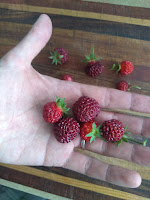
Virginian strawberry (Fragaria virginiana) are a species of wild strawberries from North America. They taste similar to garden strawberries you can buy from the markets but with far more intense and sweet flavour. These have been selectively bred for larger sized berries as wild plants produce tiny berries. Berries have deeply set seeds. Grows lots of runners, flowers twice per year in my garden. Very hardy plants $5 per plant
Carnivorous Plants
I
know this page is mostly for perennial vegetables and other organically
grown edibles, but please don't get confused and start to eat your
carnivorous plants!
Venus Flytrap (
Dionaea muscipula) are the most famous and one of the most intriguing of carnivorous plants. They grow best in areas
with frosts
but can be grown in frost free climates. Never shut the
traps with your finger, don't feed them, and don't fertilise them.
Growing notes can be found here.
$8 each
small bare rooted plant
Cape Sundew (
Drosera capensis)
is one of the easiest of all carnivorous plants to grow. They were the
first carnivorous plants I ever grew successfully as a child and from
them I learned how to grow other carnivorous plants. These catch numerous
flies, moths, mosquitoes, and other insects. Don't feed them unless you know what
you are doing or you may kill the plant. Grow them in damp peat moss (never
soil) in a tray of water, never fertilise, and protect from heavy frosts. They tend to lose their 'dew' and sulk after being posted, but it doesn't take them long to pick up again. You choose between 'typical' and 'alba' varieties. $6 per small plant
Cape Sundew (
Drosera capensis)
SEEDS. These carnivorous plants are surprisingly simple to grow from seed but
very few places ever list seed for sale. Simply place damp peatmoss in a
small pot, keep a tray of water under at all times, and sprinkle the
fine dust like seeds on top. Most will germinate in a few weeks. I have 'typical' has red tentacles and pink flowers, 'alba' has green or light pink tentacles and white flowers. Seeds are tiny as per the picture on the left. The seed packet is a mix of 'typical' and 'alba' seeds $4 per packet containing hundreds of tiny freshly collected seeds
Ornamental - non-edible plants or seeds 
















